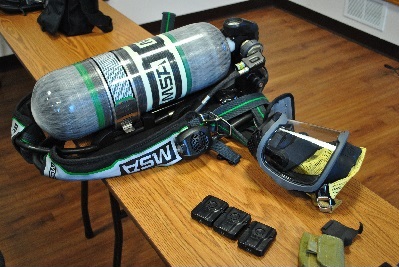Smoke, burning debris and intense heat dramatically increase the chances of a firefighter becoming disoriented and getting lost inside of a structure. GPS units are unable to track their locations within these types of dangerous situations, and so when separated from their team, a precious few seconds can make a world of difference to a firefighter in danger. The Department of Homeland Security Science and Technology Directorate (S&T) has developed a system to help overcome this issue.
S&T’s First Responders Group (FRG), alongside the National Urban Security Technology Laboratory (NUSTL) and the Herman Volunteer Fire Company (VFC), conducted an operational field assessment of the Firefighter Accountability and Proximity System (FFAP) in late January. The FFAP beacon measures the relative distance and relative elevation between beacons worn by firefighters or other first responder personnel during dangerous emergency situations, rather than globally positioning a firefighter as an isolated unit. The device is intended to improve team situational awareness and to aid in quickly finding lost or down firefighters inside of a burning building.
The proximity sensor relies on a method called “time of flight” to provide accurate distance measurement between itself and the other proximity sensors. A signal is sent back and forth at the speed of light between proximity sensors within range. The time the signal takes to travel between the proximity sensors is used to calculate the distance between the two sensors.
“The proximity sensor also makes use of a technology known as ultra-wide band (UWB). UWB technology transmits information over a large spectrum bandwidth, 500 MHz or greater. UWB allows for a more accurate measurement of distance and proved to be resistant to multipath induced errors,” NUSTL Team Evaluator Bhargav Patel said.
The recent field assessment provided developmental guidance and next steps in finalizing the FFAP design and beta-group deployment to the field.
FRG plans to distribute 100 units to first response agencies to use in their operational environments for further feedback. Eventually, FFAPs will be integrated into self-contained breathing apparatus equipment to help firefighters carry out their work efficiently while staying safe.”
“Anything that can protect our firefighters could potentially be a lifesaving tool. The FFAP System has some great features including the ability to tell us how long they have not been moving. Other firefighters or a Rapid Intervention Team may be able to use this device and help locate the down firefighter during that critical period of time,” said Herman VFC Fire Chief and First Responder Resource Group member Rob McLafferty.
FRG conducts field assessments to test technologies with the first responders who will actually use them in practice. The Herman county volunteer responders, based in Butler County, Pennsylvania tested the FFAP’s features to help determine whether it is a viable solution for the nation’s first responder community.
“We’re looking at this from a command situation. By making this as realistic as a simulation as we possibly can, this will allow us to find the strengths and weaknesses of this program. FFAP could be used in a search and rescue type situation, wildland fires or many other types of applications,” said McLafferty.
“The feedback received during the field assessment will be implemented into the final FFAP design and then 100 production units will be built,” concluded S&T FRG Responder Technology Program Manager Christine Lee said.” FRG plans to distribute these 100 units to first response agencies to use in their operational environments for further feedback. Eventually, FFAPs will be integrated into SCBA equipment with the goal of helping firefighters carry out their work efficiently while staying safe.”
NUSTL is preparing the field assessment lessons learned, which will be shared on FirstResponder.gov in the coming months.
For more information on the Firefighter Accountability and Proximity System, please contact first.responder@dhs.gov.

